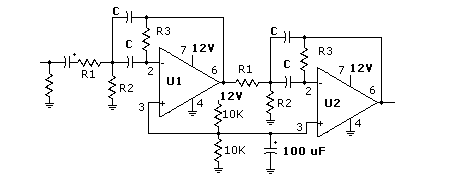


Active band pass filters are simply filters constructed by using operational amplifiers as active devices configured to simulate inductors or what are known as "gyrators". Active band pass filters are used largely at audio frequencies where otherwise the size of the inductor would become prohibitive. The are many different types of active filters including high pass, low pass, band reject and there are numerous responses including multiple feedback band pass (MFBP), dual-amplifier band pass (DABP) and, state variable bi-quad all pole circuits. Interestingly all known filter responses such as Butterworth and Chebyshev may be synthesised.
Here we will only consider the time honoured multiple feedback band pass (MFBP) type which uses capacitors of equal value and leads us to simplified calculations. Let's look at the basic circuit in figure 1 below.

Figure 1 - an active band pass filter
Now the calculations are fairly simple. You need to determine several things first, Ho the gain per stage, Q the bandwidth and Wo which is 2 * pi * Fc.
Finally pick a convenient value for C which if reasonably large, leads to smaller values of resistance and consequently some aid in reducing noise.
Valuable feedback (no pun intended) from readers using rate-this-page (see below and on every other page) indicates the following needs clarification:
(a) the 100 uF capacitor above is purely part of the power supply reservoir and has nothing to do with the filter itself. The two 10K resistors are part of the power supply biasing of the op amps because we are not using positive and negative power supplies.
(b) The capacitor and resistor values are simply the value of C you choose to use and the resistor values result from the following calculations. It's that simple.
We'll proceed with a typical design example and say we need an audio filter for a CW receiver. Fc will be 750 Hz, gain per stage we'll fix at 3 and we'll make the bandwidth 150 Hz leading to Q = 750 / 150 = 5. For convenience C will equal 0.027 uF being a polyester capacitor we have on hand.
NOTE: If the calculations below look funny to you in Netscape, just hit the reload button - just another Netscape "quirk" we poor web designers have to live with.
Calculate R1 firstly:
R1 = Q / [ Ho * Wo * C ]
= 5 / [ 3 * 4712.4 * 0.027 X 10 - 6 ]
= 5 / 0.0003817 = 13099 or 13K
Next calculate R2:
R2 = Q / [ ( 2 * Q2 - Ho ) * C * Wo ]
= 5 / [ ( 2 * 52 - 3 ) * 0.027 X 10 - 6 * 4712.4 ]
= 5 / [ (50 - 3 ) * 0.000127234 ] = 5 / .00598 = 836 or 820R
Finally calculate R3:
R3 = 2 * Q / [ C * Wo ]
R3 = 10 / [ 0.027 X 10 - 6 * 4712.4 ]
R3 = 10 / [ 0.000127234 ] = 78,595 or 75K
Resistors in this application could be typical 5% types but in Australia 1% metal film types in the E24 series don't cost much more anyway. The capacitor would be a 5% "Greencap" type. Notice with the resistors I've gone for the nearest standard E24 value.
The IC could be 741 op amps or for significantly improved performance select one of the better quality low noise types such as Philips NE/SA5534 premium low noise operational amplifiers (op-amps).
Pay particular attention to the two 10K resistors splitting the 12V power supply to correctly bias the non-inverting (pin 3) input of the op-amps. You can add as many stages as you wish for sharper cut off (shape factor) but I don't believe more than two stages are usually justified
For this kind of active band pass filter don't try for very high Q's or very high gains.
passive band pass filters
passive high pass filters
passive low pass filters
NE5533 / NE5534 low noise operational amplifier data sheet - (109K) in PDF format.
Bibliography: - Philips Semiconductors - Semiconductors for Wireless Communications 1999 - IC17